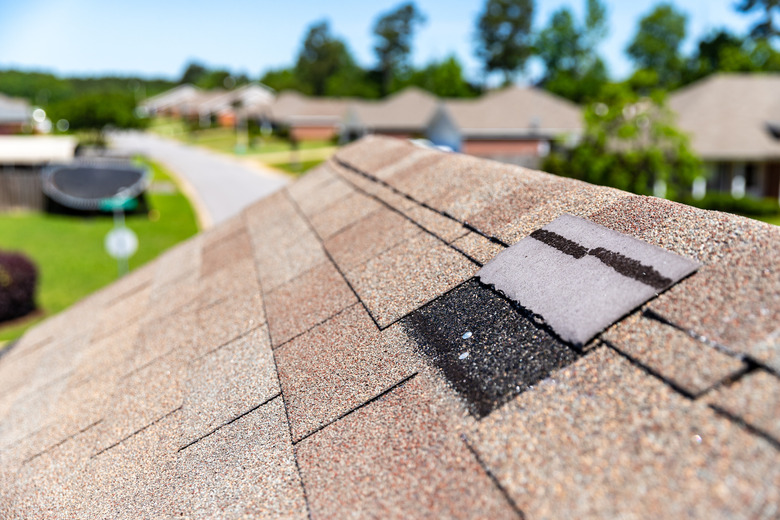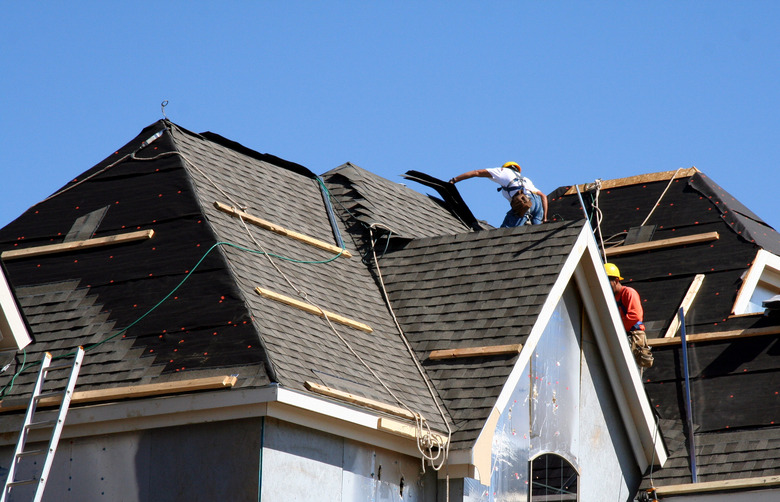How To Find And Fix Wind Damage On Roofing
We may receive a commission on purchases made from links.
You rode out the worst of the storms, and the clouds are finally parting, but what kind of damage did your roofing sustain? Strong storms can cause all types of damage, from flooding to downed power lines — and they can also wreak havoc on all types of roofs, which can lead to secondary damage, like leaks and structural issues. Acting fast once the storm passes can minimize the harm and allow you to restore your roofing quickly.
Basics of Wind Damage
Basics of Wind Damage
It's not just tornados and hurricanes that can tear off roofing and damage your home. Straight-line winds can be just as damaging, whether it's sustained high winds or strong gusts. Wind gusts can sometimes reach up to 100 miles per hour or more, and your roof often takes the brunt of a windstorm because of its high position and the way the wind hits it. While higher winds are more likely to cause damage, winds in the 50- to 70-mile-per-hour range can still cause significant damage.
Wind doesn't hit the roof uniformly. You're more likely to see damage on the corners and edges of your roof or where shingles are already loose. The damage can travel up the roof once it loosens the roofing material at the edges or corners. Older roofs are especially susceptible to damage since sealant and roofing cement used on the roof can fail. Shingles that are already worn, curled, or loose often can't withstand high wind speeds.
Roofs also get hit with falling or flying debris, such as tree branches. Minor damage from flying debris can simply gouge or scratch the roofing material without punctures through the roof. Strong winds can send tree branches completely through the roof, leaving large holes and damaged shingles. Since wind damage often happens during thunderstorms, you might also have hail damage on your roof.
Signs of Roofing Wind Damage
Signs of Roofing Wind Damage
After the storm passes and it's safe to go outside, you can start to look for signs of roof damage. Check out the area first to look for downed power lines, broken tree branches, and debris that could be dangerous to walk near. If you choose to climb a ladder to inspect the damage, remember some basic roof safety tips to prevent falling. Some signs of roofing damage can be seen from the ground, while others are only visible if you climb up to the roof (so if you're at all uncomfortable with climbing up and walking around, it's best to call in a professional to check things out).
Some signs of wind damage include:
- Shingles in your yard
- Missing shingles
- Shingles that are misplaced, cracked, missing pieces, or otherwise damaged
- Unusual gaps between the shingles and the roof
- Water leaking inside your home or discoloration on your ceiling
- Granules in your gutters from asphalt shingles or visibly missing granules when you look at the shingles
- Torn, buckled, or punctured flashing
- Bent or damaged gutters or loose gutter fasteners
- Flapping shingles or horizontal creases on shingles
- Visible punctures and holes through the roof seen from above the roof or inside your attic
- Cracked, detached, or damaged soffit and fascia boards
- Twisted or shifted chimney or bricks missing from the chimney, which can damage the shingles or flashing around it
Document any signs of wind damage that you see. Taking photos of the damage is the easiest option, but taking notes can help you remember the details as well.
Tip
Before a storm ever hits, it's a good idea to take photos of your home's exterior so you can have easy before-and-after comparisons when an insurance adjuster assesses the damage.
Getting a Roofing Inspection
Getting a Roofing Inspection
Even if the roof wind damage seems minor, homeowners should get an inspection from a reliable roofing contractor to look for additional damage after a major storm hits. Many roofing companies offer free inspections of your roof and will give you a detailed estimate if damage is found. To spot the damage, the company might use drones or climb ladders to the roof — but in all likelihood they will spot things you missed or issues you didn't know were problematic.
If you end up filing an insurance claim for the project, the insurer will likely send out its own assessor to inspect the damage firsthand. This assessment — not any contractor's inspection — will then become the basis of the claim benefit.
Talking to Your Insurance Company
Talking to Your Insurance Company
Check with your insurance company to see if filing an insurance claim for the damage is an option. Significant wind damage often falls under your homeowners' insurance coverage, which can help pay for part of the repairs. Call your insurance agent as soon as possible to start the claims process. You'll likely need to file the claim before you start the repair work, and you could be penalized if you fail to file the claim within a certain time frame.
Most insurance companies send inspectors or adjusters to look at the roof, who will take photos and make notes about the roof's condition. This information helps the insurance company determine how much it will pay for the roof claim.
Repairs vs. Replacement
Repairs vs. Replacement
Should you have a new roof installed or repair the shingle damage? This decision usually comes down to the extent of the damage and the age of your roof. Minor damage on shingle roofs can often be easily repaired by professional roofers. For example, a small area of missing or damaged asphalt shingles with no underlying damage is a quick fix.
Older roofing systems that are due to be replaced soon anyway are often good candidates for roof replacement after a storm. A roofer could piece together a repair, but the replacement shingles will look significantly different than the older, worn shingles. The roofing also might not hold up well if another bad storm hits since the shingles' integrity may have been compromised.
Replacing the entire roof is more expensive, but it gives you an updated roof with a uniform look. A patch job where the shingles stand out can decrease the value of your home, which could be a deciding factor if you're planning to sell soon. Replacement is sometimes the only viable option if most of the shingles are damaged or there's significant structural damage to the roof. Working with a professional roofing contractor (and your insurance company) is the best way to decide what to do. Your roofer can explain the extent of the damage and the appropriate options to help you decide how to handle the remediation.
Choosing a Qualified Professional
Choosing a Qualified Professional
There are many places to find contractors for your roof replacement or roof repair. Recommendations from friends and neighbors come with accounts of personal experiences, so you can get an idea of how good the roofing contractor is and what he's like to work with. Online service directories and consumer review sites let you see ratings and reviews about contractors to alert you to potential red flags.
Once you narrow down the roofing contractors, verify that each one is licensed and insured. Verify how long the company has been in business. Some subpar contractors pop up overnight when major storm damage hits an area and should be avoided in favor of a well-established, local company with a proven track record in the community. Review the warranties offered for roofing repair work. Ask for detailed estimates to help you compare the pricing and what each company plans to do to fix the issue.


